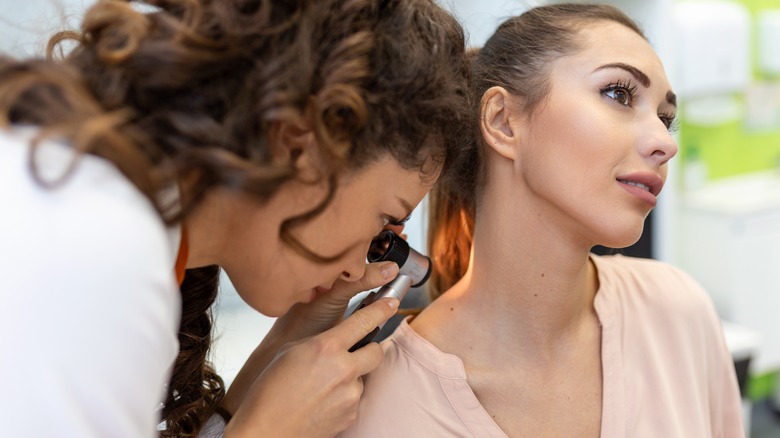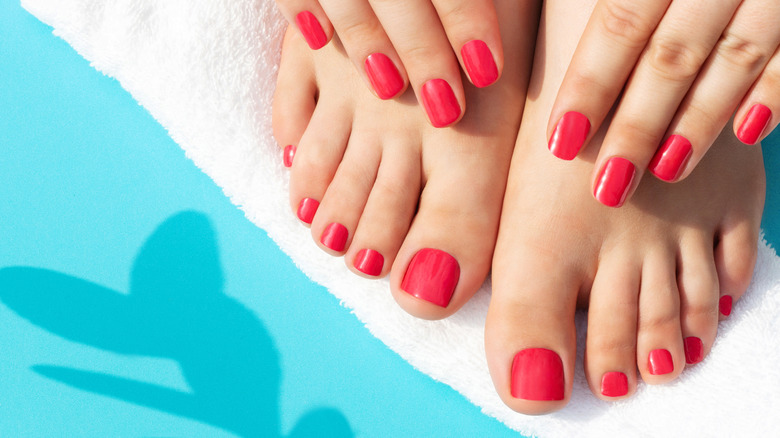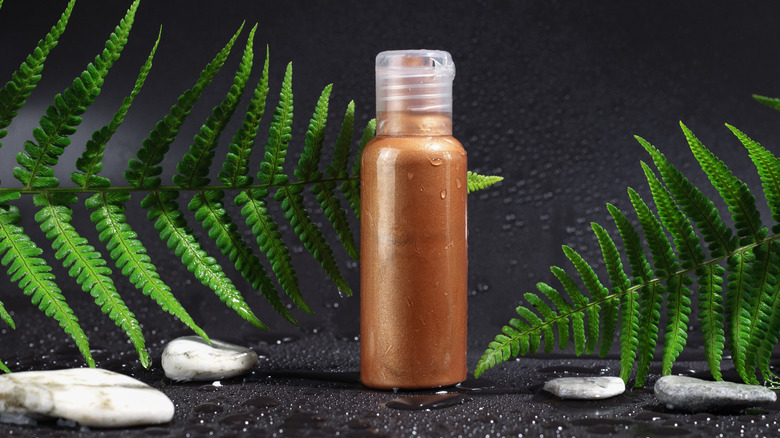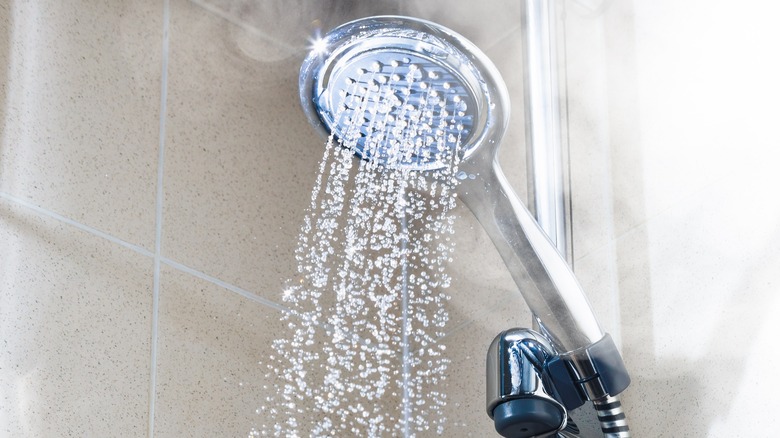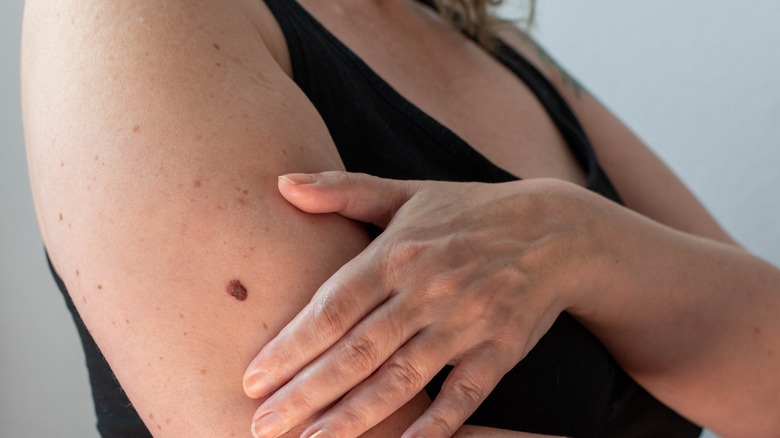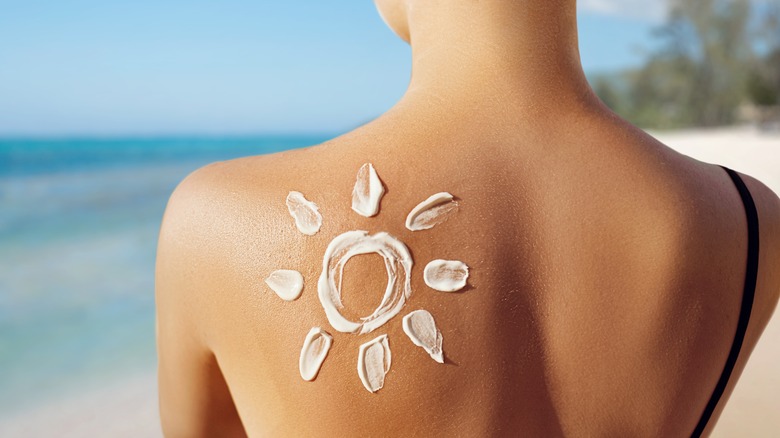Our Dermatologist's Tips For The Night Before A Skin Exam (Including The Activity You Should Skip)
If you ask most people what a dermatologist is, they'll likely say a skin doctor. If you pressed them further, they might mention specific health concerns, like how dermatologists help with acne or check moles to make sure they aren't cancerous. And while all this is true, it's not the whole story.
Yes, a dermatologist is a type of medical doctor, and skin conditions are part of their expertise, but they can also help with health concerns related to hair and nails (via the American Academy of Dermatology Association). Patients see dermatologists for cosmetic reasons like wrinkles and scarring, as well as ones related to quality of life. For example, eczema can interfere with getting a good night's sleep. And depending on its location, a birthmark can be detrimental to one's eyesight. Additionally, dermatologists can help with dangerous health issues. These include not just diagnosing diseases, but also recognizing symptoms (like how itching can be a red flag of severe liver problems).
Although dermatologists identify and treat thousands of diseases, what you do and don't do can make a big difference at your next dermatology exam. Not only can they lead to a more pleasant experience, but in some cases, they can also help you get a proper diagnosis. And the best part? Some of them could easily be done the night before your appointment. Read these tips shared by Dr. Bradley Glodny, a board-certified dermatologist and owner of Park Ave. Derm., in an exclusive interview with Health Digest.
Remove all nail polish from your fingers and toes
Imagine this: A woman (we'll call her Sara) treats herself to a manicure and a pedicure. As she walks out of the nail salon, she gets a call from her dermatologist's office, reminding her that she has an appointment the next day. Annoyed, Sara decides she isn't going to ruin her mani-pedi for a checkup. Sara, however, could be making a dangerous mistake.
"Make sure you remove all nail polish from fingers and toes," Dr. Glodny told Health Digest. "While less common, skin cancers can develop beneath your nail. If you are wearing nail polish, it may hide any signs of skin cancer." In fact, the deadliest of all skin cancers, melanoma, can occur under and/or around the nails on the fingers and the toes (via AAD). Warning signs of melanoma include nails lifting away and separating from the nail bed, nails splitting down the middle, bumps under the nails, the skin around the nails becoming darker, and a dark streak on the nails themselves.
While it's good to recognize possible signs of skin cancer, it's also important not to self-diagnose. Instead, note any changes, and as the AAD recommends, have a board-certified dermatologist examine you and address your concerns. Most importantly, if you do see possible red flags of skin cancer, especially melanoma, don't delay making an appointment with your dermatologist.
Wear clean, easy-to-remove clothing
You're laying out your clothes for your morning dermatology appointment. Since you have a mole on your neck, you quickly decide against wearing a turtleneck sweater. While this was a good decision, it's not the only thing to consider when picking out what to wear for a dermatology exam.
Even if you have a specific reason for making this appointment, that doesn't mean the dermatologist will limit the examination to just one area of your body. According to Connolly Dermatology, getting a checkup from a dermatologist can involve removing all of one's clothing except for undergarments. This is to allow the dermatologist to fully examine a patient for any possible skin concerns and health issues. As Dr. Glodny told Health Digest, "Plan to wear clothing that can be easily removed or maneuvered so your dermatologist can see all of your skin." So, let's say that mole is on your upper arm instead of your neck. The last thing you want to wear is a top with tight-fitting sleeves.
Even though a dermatology exam can involve a full body check, that doesn't mean you can't focus some of the exam on specific concerns. As Connolly Dermatology explains, the dermatologist typically begins an examination by talking with you and asking questions like, "Do you have any moles?" And one final clothing tip from Dr. Glodny: "Make sure your clothing is clean."
Remove fake tans and tinted moisturizers
Sunless tanning products include spray tans and self-tanner lotions (via Dermassociates Ltd.). Meanwhile, tinted moisturizers are water-based creams that contain colored pigments and are meant for use on the face (per MasterClass). Additionally, these moisturizers are thinner than another facial product: foundation. But no matter which of these products someone uses, they can be an issue during a dermatology exam.
"Make sure you have removed all fake tan or tinted moisturizers, which may change the appearance of your moles," Dr. Glodny told Health Digest. In fact, the Siperstein Dermatology Group advises not using spray tans or self-tanners one to two weeks before a skin exam. And even though foundation isn't the same thing as tinted moisturizer, the Group also recommends taking off all makeup before a dermatology exam.
While removing tinted moisturizers can be as simple as removing foundation, sunless tanning products are another matter. According to Healthline, exfoliating (just don't overdo it) and warm soaks can help specifically with dark patches and streaks sometimes caused by self-tanners. And there are creams and mousses designed to remove self-tanners (via MasterClass). With that said, skin sensitivities can vary from person to person. So, before trying anything, familiarize yourself with the product's ingredients. You may also want to speak with your dermatologist beforehand for advice.
Shower to get ready for your appointment
This might surprise you, but according to Metrolina Dermatology and Skin Surgery Specialists, there's debate among dermatologists about how often a person should shower. Then again, varying factors can affect one's shower schedule, like how oily a person's skin is, environmental considerations (such as if someone works outdoors or indoors), and how frequently someone sweats. But no matter what your shower routine is, it's very important to shower to get ready for a dermatology appointment.
"Make sure to shower the night before or in the a.m. before your skin exam to ensure your skin is clean and easily evaluated by your dermatologist," shared Dr. Glodny. Okay, so a long shower before seeing your dermatologist is a must, right? Actually, while the shower part is important, long showers could be bad for one's skin, since you might lose too much oil (via Metrolina Dermatology and Skin Surgery Specialists). Instead, limit a shower to around 10 minutes, don't use very hot water, and when you're done, use moisturizer.
Additionally, what you use to clean your skin in the shower can make a big difference when it comes to your skin's overall health. For instance, what kind of soap do you use? If it's harsh, you might want to switch to a gentle perfume- and fragrance-free cleanser. You might also want to stop using physical exfoliators (or at least reduce how often you use them).
Write down your top one or two concerns
It's the night before your dermatology appointment, and suddenly, thoughts like "Is this a new freckle?" and "Is this a sunspot or something worse?" start racing through your mind. Before you know it, you have a long list of concerns about your skin, ranging from moles to wrinkles.
Feeling a bit nervous before any kind of checkup is normal. But keep in mind that, per Connolly Dermatology, a full body check usually takes only 10 to 15 minutes. Unsurprisingly, Dr. Glodny gave this bit of advice: "Choose 1-2 other concerns you may have about your skin (not related to moles) you would like to discuss. Try your best to avoid overwhelming your dermatologist with too many concerns. This may lead to your major concerns not getting fully addressed since there is only so much time in a visit."
If you're still unsure which concerns to prioritize for your appointment, the Skin Cancer Foundation notes that moles aren't the only possible red flags of skin cancer. For example, skin that's crusty or bleeding could be a warning sign of squamous cell carcinoma. As board-certified plastic and reconstructive surgeon Dr. Darrick Antell said, "If it's new, changing size or shape, or bleeding, don't ignore it. When in doubt, get it looked at by a professional." Finally, if there isn't time to discuss all your concerns, schedule a follow-up appointment right away.
Note any changes in your moles
Are moles dangerous? The answer is they can be. Basically, a mole is a kind of skin growth that tends to be a brown spot but can also be blue, black, pink, or red, and can vary in texture, shape, and size (via Mayo Clinic). Moles can form anywhere on a person's body and change over time. So, it's important to self-monitor and let your dermatologist know about any new moles or changes to existing ones.
"Think to yourself if you have noted the development of specific new moles or changes in old moles," Dr. Glodny told Health Digest. "Change in shape, size, color, and/or texture could be a sign of skin cancer. Therefore, it is best to point out any changes to your dermatologist."
As the Mayo Clinic explains, checking your moles for potential signs of skin cancer is as easy as ABC — or in this case, ABCDE. First, is the mole asymmetrical instead of round or oval? Next, is the mole's border scalloped, notched, or irregular? Also, does the mole have an uneven color, or has it changed color? Has the diameter of the mole increased? And has it evolved in any way (for example, has it changed in height, or does it itch or bleed)? Answering yes to any of these questions could mean that the mole is cancerous.
Don't get a suntan
Suntans and skin damage go hand in hand (via the Food and Drug Administration). In fact, a tan occurs because the body is trying to keep the skin from becoming more damaged by the ultraviolet radiation (UV) in the sun's rays. But aside from skin damage, a suntan can also interfere with a skin evaluation.
As Dr. Glodny shared with Health Digest, "Do not come in for your skin exam with a tan (from the sun) because this will change the way your moles appear and can sometimes lead to unnecessary biopsies." Biopsies are when a medical professional takes cells or tissue from an area of the body for further testing (per Mayo Clinic). A shave biopsy, for example, involves scraping the skin. Meanwhile, a punch biopsy requires taking a circular sample from the deeper layers of the skin. Both incisional biopsies (where a small section of skin is removed) and excisional biopsies (where a large area of skin or a lump is removed) can require stitches, although with incisional biopsies, it depends on how much skin is removed.
So, what should you do if you have a suntan and an upcoming dermatology appointment? Well, Dr. Glodny recommends letting it fade "before visiting your dermatologist for a skin examination." Just keep in mind that a suntan can take seven to 10 days before it begins to go away, according to Healthline.

